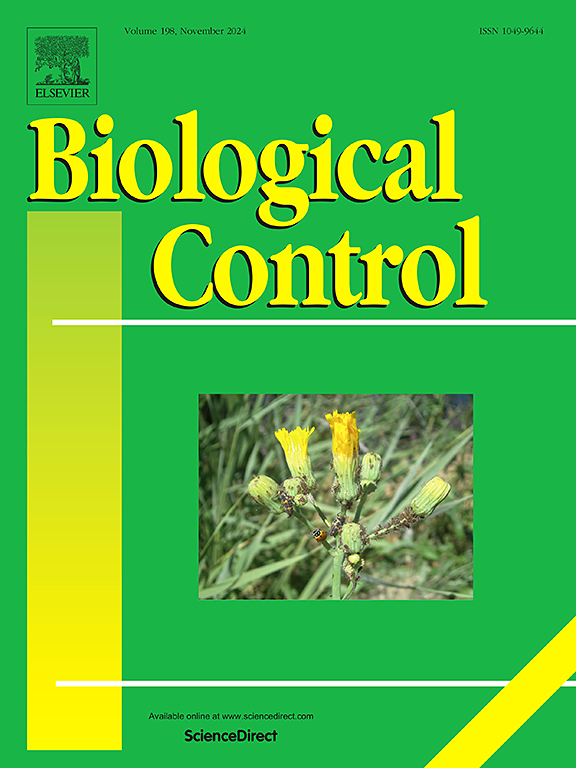Flower strips enhance the abundance and biocontrol services of predatory arthropods in a pear orchard
IF 3.7
2区 农林科学
Q2 BIOTECHNOLOGY & APPLIED MICROBIOLOGY
引用次数: 0
Abstract
Habitat management, such as the planting of companion plants, enhances biodiversity and biological control in agricultural systems. Here, we focused on the abundance, spillover, and biocontrol abilities of predators in pear crops with companion flower strips. Companion plant Cnidium monnieri attracted four predator species: Harmonia axyridis, Propylaea japonica, Chrysoperla sinica, and Episyrphus balteatus. Predator abundance during the full bloom stage of C. monnieri was significantly higher than during the other stages. The predator H. axyridis present on flower strips migrated to pear trees at distances of 2–18 m from the flower strips. The predators inhabiting the pear tree migrated to the flower strips after pest control; approximately 28.89 % of the predators onflower strips originated from the pear trees. Exclusion cage tests quantitatively assessed predator-mediated biological control of pear psyllids and showed that the control effect decreased as the distance from the C. monnieri strips increased. The biocontrol services index was 2.24 times higher at a distance of 2 m from the C. monnieri strips than a distance of 18 m. Our results suggest that companion plant C. monnieri enhances the predatory natural enemy population and effectively suppress the pear psyllid population in pear orchards.

花带提高了梨园捕食性节肢动物的丰度和生物防治作用
生境管理,如种植伴生植物,可提高农业系统的生物多样性和生物防治。本文研究了伴花带梨作物中天敌的丰度、外溢性和生物防治能力。伴生植物蛇床草吸引了4种掠食物种:毛缕草、日本丙叶、中国金菊和balteatus。全花期捕食者丰度显著高于其他花期。花条上的捕食者灰蚜在距离花条2 ~ 18 m的范围内迁移到梨树上。害虫防治后,栖息在梨树上的天敌向花带迁移;花条上约28.89%的捕食者来自梨树。排除笼试验定量评价了捕食者介导的梨木虱生物防治效果,结果表明,随着距离梨木虱条的距离增加,梨木虱的防治效果降低。距离2 m处的生物防治服务指数是距离18 m处的2.24倍。结果表明,梨园中伴生植物monnieri能有效抑制梨木虱的种群数量,增加了梨园天敌的数量。
本文章由计算机程序翻译,如有差异,请以英文原文为准。
求助全文
约1分钟内获得全文
求助全文
来源期刊

Biological Control
生物-昆虫学
CiteScore
7.40
自引率
7.10%
发文量
220
审稿时长
63 days
期刊介绍:
Biological control is an environmentally sound and effective means of reducing or mitigating pests and pest effects through the use of natural enemies. The aim of Biological Control is to promote this science and technology through publication of original research articles and reviews of research and theory. The journal devotes a section to reports on biotechnologies dealing with the elucidation and use of genes or gene products for the enhancement of biological control agents.
The journal encompasses biological control of viral, microbial, nematode, insect, mite, weed, and vertebrate pests in agriculture, aquatic, forest, natural resource, stored product, and urban environments. Biological control of arthropod pests of human and domestic animals is also included. Ecological, molecular, and biotechnological approaches to the understanding of biological control are welcome.
 求助内容:
求助内容: 应助结果提醒方式:
应助结果提醒方式:


